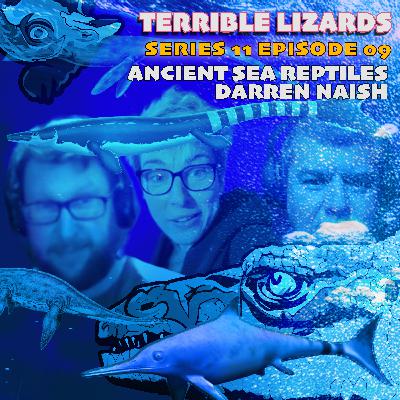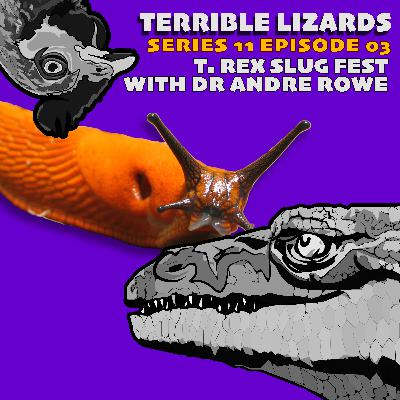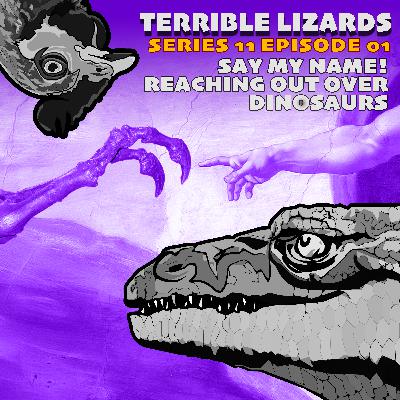Discover Terrible Lizards
Terrible Lizards

110 Episodes
Reverse
Dave has *another* book coming out and so of course he wants to talk about it a bit on the pod. Happily for the listeners, this time out he has a coauthor and so we get to have palaeontologist and palaeoartist Mark Witton on as well so that Iszi has some support for once. The new book is on that most controversial of dinosaurs, Spinosaurus and its allies, and what we know, and what we don't, and where the research is taking us. Given its insane media profile and the attention it attracts, as well as the back-and-forth in the scientific literature over its bizarre features, this is an animal well overdue a proper popular science book. So here it is, written by Dave and Mark, and with Mark's extensive illustrations throughout. But for now you can enjoy the chat about this animal and how the work came to be. Links: For Bonus content: https://www.patreon.com/terriblelizards Mark's website with links to his blog and other pages Home | MarkWitton.co.uk An old blogpost of Dave's which looks at the main controversies of Spinosaurus swimming The evidence for Spinosaurus being a specialist aquatic predator and good swimmer is weak | Dave Hone's Archosaur Musings
Long time listener and second time guest Darren Naish joins us to talk about marine reptiles. While Darren is best known for his work on dinosaurs and pterosaurs, he has fingers in a huge number of vertebrate pies, and he has a new edition out of his book on all of the Mesozoic monsters that lived in the sea. So, strap in for an incredibly being tour of mosasaurs, mesosaurs, placodonts, ichthyosaurs, plesionsaurs, thalattosaurs, thalattosuchians and we even manage to sneak in a reference to certain allegedly semi-aquatic large theropods. Support us on www.patreon.com/terriblelizards Check out iszi's NEW podcast about Egyptology www.talklikeanegyptian.com A link to Darren's Home page which combines links to the blog, podcast, con and other resources. https://tetzoo.com/ A link to Darren's post on the launch of the first edition: https://tetzoo.com/blog/2023/2/27/ancient-sea-reptiles-is-out-now A link to the Natural History Museum shop for the book: https://www.nhmshop.co.uk/ancient-sea-reptiles-plesiosaurs-ichthyosaurs-mosasaurs-more.html?srsltid=AfmBOorc2zt792sWSVYdef8-O5zKci9w2Fiu6FhLlpX_lEATiWy1Gsn0
Disaster with the recording this episode! Sorry if it is hard to hear in places we were forced to use the emergency back up! Disaster with the recording this episode! Sorry if it is hard to hear in places we were forced to use the emergency back up! Listeners may remember that Dave went to Utah a couple of years back to try and help with a sauropod excavation. That trip was with sauropod supremo Matt Wedel who was recently in London, and so we scooped him up to get him onto Terrible Lizards. Unfortunately there were real technical issues, so the sound quality is not the best, but hopefully you can enjoy it. So sit back for an hour for deep sauropod nerdery, covering the air sac system, giant sauropods, their evolution, ecology, and follow Matt's career from a chance start on a new giant to bird physiology. A link to Matt's blog SV-POW! which he writes with Mike Taylor (and in theory, Darren Naish) https://svpow.com/ A link to an old post from Matt on Dave's blog about his favourite work: https://archosaurmusings.wordpress.com/2017/02/27/buried-treasure-matt-wedel/ Iszi's book The Time Machine Next Door: inventors and dinosaurs is out on 28th August in the UK: https://amzn.eu/d/dqPr6bo
Pterosaur soft tissues It's a double new paper episode this time as thanks to the magic of almost random review and publication times, Dave has two papers out on the same subject in the same month! So strap in for some absolute minutiae on pterosaur hands, feet, scales, and the oddly overlooked wing membrane that sits between their legs. Pterosaurs in general are not very common fossils and so it should be no surprise that we don't have a great many examples of their soft tissues, from skin, to beaks and claws and other bits. So, having new examples, and synthesising the limited information we have, is really important for building an understanding of these incredible animals. It's deep dive time. A link to Dave's blogpost on the new hand and foot scale papers: https://archosaurmusings.wordpress.com/2025/06/10/new-data-on-pterosaurian-soft-tissues/ A link to a very old blogpost about pterosaur soft tissues generally: https://archosaurmusings.wordpress.com/2008/07/25/pterosaur-soft-tissues/ Iszi'a new book - featuring a pterosaur and perfect for 6-9 year olds is out on 28th August in the UK: https://amzn.eu/d/9kFiniD (message her on iszi.com if you want international posting).
June, rather incredibly, marks the fifth anniversary of the launch of series 1, episode 1 of the podcast. As a rather fortuitous bit of timing, we were invited to host a live Terrible Lizards event at Lyme Regis (home of Mary Anning) for their Fossil Festival. We could hardly say 'no', so here is a recording of that hour long session where we fielded a ton of questions from the audience (that was overflowing out of the room!) and even included a few professional palaeontologists in the audience to put a bit more pressure on Dave's answers. A good time was apparently had by all, maybe this will happen again next year? A link to the Fossil Festival website. Stay tuned for next year's details: https://fossilfestival.com/ For extra content go to patreon.com/terriblelizards
Curating Dinosaurs II Curate Harder! On this episode we welcome Jordan Mallon, a long-time collaborator of Dave's and, against the odds, a long-time listener of Terrible Lizards. While we talk about Jordan's research and career in this pod, and his work on dinosaur sizes and ecology, this one also serves as something of a sequel to our previous episode. That's because he is also the curator of the Canadian Museum of Nature in Ottawa, the national natural history museum of Canada. It's a much more typical collection than the one we talked about last time out, so join us to learn more about how museum's work, the importance of the behind-the-scenes jobs that people do, and Links: Support us and get extra content: https://www.patreon.com/terriblelizards A short interview Jordan did with Dave years ago: https://archosaurmusings.wordpress.com/2017/03/06/buried-treasure-jordan-mallon/ A blogpost by Dave on his paper with Jordan on giant T. rex. https://archosaurmusings.wordpress.com/2024/07/24/on-the-trail-of-giant-tyrannosaurus-rex/ Jordan's webpage at the Canadian Museum of Nature https://nature.ca/en/our-science/science-experts/jordan-mallon/
We have talked about all manner of fundamentals of research on fossils over the years here on Terrible Lizards, including finding and excavating fossils, writing and publishing papers, reconstructing animals from fragments and more. But we've somehow really glossed over the role of museums that store and protect fossils and make them available for research, as well as carrying out their own work too. In order to correct this oversight, today we welcome ReBecca Hunt-Foster who is the curator on the legendary Dinosaur National Monument in Utah. Here she takes us through her background and research and the challenges of looking after one of the most famous and important dinosaur sites in the world. Links: https://www.patreon.com/terriblelizards ReBecca on Bluesky: @dinochick.bsky.social Here's the link to the US National Parks website about Dinosaur National Monument: https://www.nps.gov/dino/index.htm An old blogpost of Dave's about the bitten baby Diplodocus femur: https://archosaurmusings.wordpress.com/2018/04/22/non-tyrannosaurs-biting-like-tyrannosaurs/
This time out we are joined by palaeontologist Andre Rowe to talk about his research into the skulls of giant carnivorous dinosaurs and what this means for their biology. This turns into a debate with Dave about how evidence can be interpreted in different ways and trying to piece together the often limited data we have to work out what these animals might have been doing. Though with her media-trained eye, Iszi wants to badge this as a heated fight over just how awesome Tyrannosaurus was (see previous episode for details). Andre takes us through the process of scanning skulls, restoring the bits and then testing ideas about bite force and skull strength and how the different giant theropod differed in their habits. Links: Support us on patreon and get extra content: www.patreon.com/terriblelizards Here's an article Andre wrote on his T. rex bite research: https://theconversation.com/tyrannosaurus-rex-didnt-get-its-ferocious-bite-until-it-was-an-adult-new-research-156668 Here is Andre's Instagram handle: @tyrannosaurrowe
This month's episode is a sort of follow-up to that from the start of the year, looking at some of the more problematic areas of dinosaurs and palaeontology when it comes to online discussions. There is an online fandom of dinosaurs that treats them like monsters or superheroes, and can fixate on what is and isn't the biggest / strongest / fastest dinosaur and who could beat up who. Joining us to discuss this is Dr Mike O'Sullivan, a palaeontologist and self-professed member of several fandoms. We talk about how this community works and what it means for scientists talking about research. Links: Support us on Patreon: www.patreon.com/terriblelizards Mike is part of Palaeogames, a company of professional palaeontologists making accurate books and games: https://palaeogames.com/ And here's their latest Kickstarter, a Dungeons & Dragons companion book: https://www.kickstarter.com/projects/palaeogames/professor-primulas-portfolio-of-palaeontology
Series 11, eh? We don't think we, or anyone else reading this, expected that. Nor did we expect issues with Dave's microphone (apologies)… Still, here we are and with more dinosaur goodness coming. We say 'coming' because this episode is far less about dinosaurs and pterosaurs than usual, but more about the mechanisms of science. In this case it's really about Dave's experiences as a science communicator and how things like this are increasingly important for science, but in the UK at least, this can be monitored and measured and so having ways to do that becomes important. And this is the central point of today's show, a call to arms for all those who are involved in sci comms and delight in sharing new knowledge to understand why it's important to credit your sources when new discoveries are made. Links: For extra content: patreon.com/terriblelizards If you want to know a bit more about REF in the UK, here's the main pages for it: https://2029.ref.ac.uk/about/what-is-the-ref/ And if we're talking communication, it seems a good time to say that Iszi and Dave are both now on BlueSky: https://bsky.app/profile/davehone.bsky.social https://bsky.app/profile/iszi.com
Thanks to Kyle, Tom, Ashley, Aurous, Wayne, Paleo Pete, Tyler, Will, Israel, Charles, James and Edward Support us on patreon.com/terriblelizards and be rewarded with extra content! We are planning on going live on isztube at 16:00 GMT on Friday 26th December. (Time may change)
Skiphosoura – the pterosaur of the gaps So last week Dave had a new paper out and this time it's a new pterosaur, named Skiphosoura bavarica (the sword tail of Bavaria) and it is both really interesting and really important for pterosaur research. It tells us a lot about the key transition of pterosaurs from the early forms through to the derived pterodactyloids, which has been a major subject of research for the last 15 years. Skiphosaura also shows us that the Scottish Dearc (that we covered a couple of years back) is much more important than previously thought and helps create a fantastic series of species where we can now track a whole series of evolutionary steps for pterosaurs. This transition really is now a great example of being able to see an evolutionary change over time in the fossil record. So strap in for some overly-detailed anatomical descriptions of bits of obscure pterosaurs! Links: Support us on patreon and get extra content https://www.patreon.com/terriblelizards Here's a link to the full paper – it's open access so anyone can read it: https://www.cell.com/current-biology/fulltext/S0960-9822(24)01377-0 And here's Dave's blog post about the specimen and it's significance: https://archosaurmusings.wordpress.com/2024/11/18/skiphosoura-solving-the-transition-to-pterodactyloids/ Link to the website of the Lauer Foundation: https://www.lauerfoundationpse.org/ The bonus episode we did on Dearc: https://terriblelizards.libsyn.com/tls06-bonus-jurassic-pterosaur-dearc-sgiathanach
Dave has a new book out next week and it's the culmination of several years work. Longtime listeners will know the major themes already from the episode title – a lot of stuff in the literature on dinosaur behaviour is badly framed, overstated, contradictory or contains major over extrapolations. Happily, you can listen to all of this again as Dave goes into all of this and more, what's in the book, who it's aimed at and what he's trying to achieve with it. It's not out till next week, so this is a bit a of a sneak preview, even if various copies have snuck out the door and some (un?)lucky people have their hands on it already. Next month will be far less sycophantic and self publicising, honest. Support us on patreon and unlock extra content https://www.patreon.com/terriblelizards Special offer! Get 30% off Uncovering Dinosaur Behavior by Dave Hone. Use code UDB30 when you buy direct from Princeton University Press. (Postage costs will be added at point of purchase. Offer available until 31 December 2024.) https://press.princeton.edu/books/hardcover/9780691215914/uncovering-dinosaur-behavior
Last month we mentioned that legendary palaeontologist Mike Benton had announced his retirement, but with a few quick emails, Dave was able to grab him for this month's episode. So, join Dave and Iszi as we have celebration of Mike's career and take him through his early interest in palaeontology, how he got his PhD, the death of Al Romer, rhynchosaurs, the rise of dinosaurs, mass extinctions, fieldwork in Russia, endless books, and his work on the colours of dinosaurs. It's a whirlwind dash through an entire so strap in for the deluge of facts and fables and enjoy. And congratulations to Mike! Links: patreon.com/terriblelizards Mike's webpage at Bristol which covers his career and achievements: https://www.bristol.ac.uk/people/person/Mike-Benton-e41eaef1-135d-40db-9b7f-e81f7d290f72/ A link to the Amazon page of (most of) Mike's books: https://www.amazon.co.uk/Books-Michael-Benton/s?rh=n%3A266239%2Cp_27%3AMichael+Benton
We've made plenty of jokes over the years about the general lack of sauropod skulls and the frustrations of trying to work out what these animals were doing when it came to things like feeding when the most important bit is missing. Happily, this week we are joined by David Button who has done a ton of work in this area and is happy to chat to Dave and Iszi about how their heads and teeth were built and what this can (and can't) tell us about their diets and habits. While we have him trapped, we also quiz him on his recent work on the behaviour of the thescelosaurs, an odd branch of dinosaurs we've taken till series 10 to even mention! Links: Extra content on patreon: www.patreon.com/terriblelizards And old post of Dave's on the sauropod skeletons in Berlin, that really show off the issue of different feeding heights in these animals: https://archosaurmusings.wordpress.com/2013/01/27/berlin-sauropods/ David's webpage at the University of Bristol: https://research-information.bris.ac.uk/en/persons/david-j-button
The spinosaurs get all the love (OK, mostly hate) and attention when it comes to the megalosauroids, but they are but one weird branch of this group of theropods. Sadly they have a similar problem to the spinosaurs in that there are annoyingly few fossils of them, and there's very few people working on these animals. Happily, today Iszi and Dave are joined by one of them, Cass Morrison who is doing his PhD on these unusual animals and is here to give us the lowdown on their evolution, diversity, biogeography and ecology and generally fill us in on these much under-appreciated animals. Links: For extra content go to our Patreon https://www.patreon.com/terriblelizards Apiece with Cass about his work on dinosaur brains: https://www.nhm.ac.uk/discover/behind-the-science-cassius-morrison.html Find Cass on Twitter https://x.com/casscretaceous and Instagram https://www.instagram.com/cretaceous.cass/?hl=en-gb
We have touched on the extinction that killed the dinosaurs plenty of times before over the various seasons of TL, but we have never really tackled it fully before. Finally, we are joined by a real expert on this subject, Melanie During who is in the process of finishing her PhD on this very subject. So prepare for not actually really any dinosaurs, but quite a lot of geology and geochemistry to learn how the impact was so utterly devastating and how we know. It turns out that they never stood a chance and that the damage was even worse than even Dave had realised. Links: support us on patreon and access extra content: www.patreon.com/terriblelizards A link to Melanie's YouTube series which is on long term hiatus but full of cool videos to watch (even if it notably fails to include a certain silver-haired pterosaur and tyrannosaur researcher): https://www.youtube.com/c/GenuineRockstars/videos Here's a link to Melanie's press stuff for her papers but it includes some videos and graphs of that we talk about https://uppsala.app.box.com/s/ikmlwtb0vui7zn5k74jfokbhysla8ck1
Live edited recording at The Oxford Fire Station on 25/05/2024. Live Anniversary Q&A for the Oxford Podcast Festival It's the 4th (!) anniversary of the launch of Terrible Lizards and this came at a perfect time as Iszi and Dave got invited to do the recent podcast festival in Oxford. So, while we have our usual end of series Q&QA episode in a few months, here we have an early one with questions from out live audience. We thought that was more appropriate then for us to just rabbit on (or dinosaur on) in front of people and it made for a pretty compelling exchange, the time simply flew by. An obviously thanks to the organisers for hosting us and especially to all the people who actually trekked there (from Edinburgh! From Germany!) and then spent actual time to just listen to us. It's still all rather confusing and unsettling, but they say it takes all sorts to make a world. Anyway, here it all and happy birthday to us, and thanks for listening. Links: Podcast festival link: https://www.saintaudiopodcastfestival.com/ Support us on Patreon for extra content: https://www.patreon.com/terriblelizards
We all know about how common dinosaurs can be in places like Europe, Argentina, the US, China and Mongolia, but they have turned up in dozens and dozens of countries and on every continent, including Antarctica. Unsurprisingly, it's a very tough place to work, it costs a ton of money, and there are not that many dinosaurs to be found, but they are there. Today we are joined by Matt Lamanna of the Carnegie Museum who has spent multiple field seasons on the chilly continent and he tells us about lush forests, tiny dinosaurs, ancient birds and modern penguins. So join us to learn about what is perhaps the last great unexplored area of dinosaurs, the bottom of the world. Links: SEE TERRIBLE LIZARDS LIVE! https://oldfirestation.org.uk/whats-on/terrible-lizards-podcast/ Matt's website on the project: https://antarcticdinos.org/ Matt's profile at the Carnegie: https://carnegiemnh.org/research/matthew-lamanna/ A short post of Dave's on the Carnegie sauropods, click through the next few posts if you want to see all of their dinosaurs: https://archosaurmusings.wordpress.com/2011/11/10/cargenie-dinosaurs/
Dinosaur footprints with Peter Falkingham Footprints and trackways are an amazing source of data on how dinosaurs moved and what they did. But interpreting these can be a real nightmare since it's hard to work out the interactions between a moving foot and the actual surface, or work out which species might have made which tracks. At the forefront of solving some of these issues and working out what we can and can't meaningfully day about dinosaur tracks is Professor Peter Falkingham at Liverpool John Moores University. So today he joins us to talk about chasing birds across mud, literal books made of fossil dinosaur footprints and using X-rays to work out how dinosaurs moved. There's so much in here and you'll never walk across a beach again without looking back at your own tracks. Links: COME SEE US LIVE!: https://oldfirestation.org.uk/whats-on/terrible-lizards-podcast/ Pete's website: peterfalkingham.com An article based on Pete's work with a load of videos of his stuff https://www.aws.amherst.edu/museums/naturalhistory/dinosaur-tracks Pete's YouTube channel with loads of videos of his projects https://www.youtube.com/@PeterFalkingham Please do support us by giving us a review and you can unlock extra content on patreon https://www.patreon.com/terriblelizards

























A very good episode and podcast. (^^,) Thanks !!